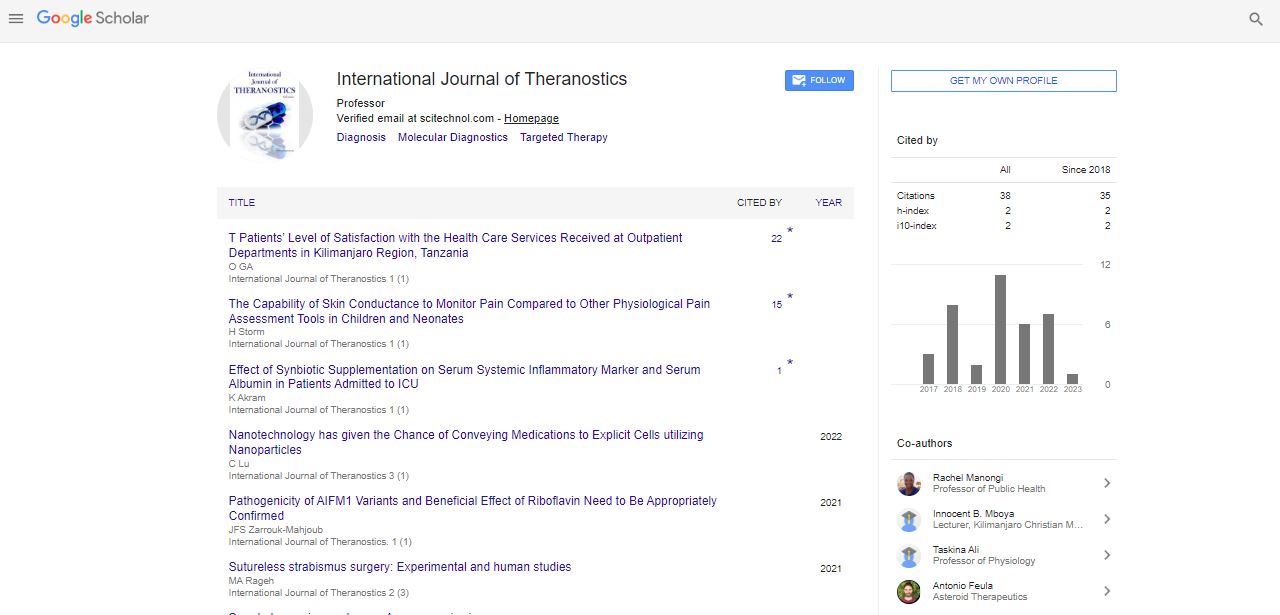Perspective, Ijt Vol: 12 Issue: 3
Concept of Polypharmacy, its Causes, Consequences, and Strategies to Help Older Adults to Manage their Medications
Ivkoc Ramos*
1Department of Imaging & Pathology, University Hospitals Leuven, Leuven, Belgium
*Corresponding Author: Ivkoc Ramos,
Department of Imaging & Pathology,
University Hospitals Leuven, Leuven, Belgium
E-mail: ramosi2@kuleuven.be
Received date: 30 August, 2023, Manuscript No. IJT-23-117617;
Editor assigned date: 01 September, 2023, PreQC No. IJT-23-117617 (PQ);
Reviewed date: 15 September, 2023, QC No. IJT-23-117617;
Revised date: 22 September, 2023, Manuscript No. IJT-23-117617 (R);
Published date: 02 October, 2023, DOI: 10.4172/IJT.1000139.
Citation: Ramos I (2023) Concept of Polypharmacy, its Causes, Consequences, and Strategies to Help Older Adults to Manage their Medications. Int J Theranostic 12:3.
Abstract
The aging population is growing, and with it comes a surge in health concerns and medical treatments. As a result, older adults often find themselves managing multiple chronic conditions and taking numerous medications. This practice, known as polypharmacy, can have a significant impact on their health and well-being. Polypharmacy is defined as the concurrent use of multiple medications, typically involving five or more, by a single patient. It often arises from the necessity to manage a variety of health conditions that become more prevalent with age, including hypertension, diabetes, heart disease, and arthritis. While each medication may be essential for treating a specific ailment, the interaction between them can result in a complex and potentially harmful medication regimen. As individuals age, they are more likely to develop several chronic health issues, necessitating multiple medications to manage these conditions effectively.
Description
The aging population is growing, and with it comes a surge in health concerns and medical treatments. As a result, older adults often find themselves managing multiple chronic conditions and taking numerous medications. This practice, known as polypharmacy, can have a significant impact on their health and well-being. In this article, we will explore the concept of polypharmacy, its causes, consequences, and strategies to help older adults manage their medications more effectively.
The complex nature of polypharmacy
Polypharmacy is defined as the concurrent use of multiple medications, typically involving five or more, by a single patient. It often arises from the necessity to manage a variety of health conditions that become more prevalent with age, including hypertension, diabetes, heart disease, and arthritis. While each medication may be essential for treating a specific ailment, the interaction between them can result in a complex and potentially harmful medication regimen. As individuals age, they are more likely to develop several chronic health issues, necessitating multiple medications to manage these conditions effectively. Some older adults experience a "prescribing cascade," where a new medication is prescribed to counteract the side effects of an existing one, leading to a snowball effect of medication use.
Patients may receive care from various healthcare providers, making it challenging to coordinate their medication regimens and leading to potential duplications or interactions. Some older adults may self-medicate with over-the-counter drugs or herbal supplements, which can interact with prescribed medications. Managing a complex medication regimen can lead to errors in dosage or timing, potentially causing harm. The more medications a person takes, the higher the risk of adverse drug reactions, which can result in hospitalization or further health complications.
Medication interactions or side effects can lead to cognitive impairment, affecting memory and decision-making abilities. Older adults experiencing the consequences of polypharmacy often suffer from a reduced quality of life due to the physical and psychological toll of managing multiple medications. The cost of multiple medications and the potential need for additional medical care to manage side effects can significantly increase healthcare expenses. Healthcare providers should regularly review an older adult's medication regimen, discontinuing unnecessary medications and simplifying the treatment plan. Patients should maintain an up-to-date list of their medications, including over-the-counter drugs and supplements, and share it with all healthcare providers.
Improved communication between healthcare providers can help coordinate care and prevent the prescription of redundant medications. The process of de-prescribing involves safely discontinuing medications that are no longer necessary or that may be causing harm. Older adults should be educated about their medications, including their purpose, potential side effects, and proper administration. Pharmacists can play a critical role in medication management by providing guidance on potential interactions and proper medication usage.
Conclusion
Polypharmacy is a growing concern among older adults, but it is not an insurmountable challenge. By understanding the causes and consequences of polypharmacy and implementing effective strategies for managing multiple medications, older adults can maintain their health and well-being while avoiding unnecessary risks and complications. The goal is to strike a balance between managing chronic conditions and ensuring that medication regimens remain safe, simple, and tailored to the individual's specific needs. In doing so, we can navigate the medication maze and help older adults lead healthier, happier lives.
 Spanish
Spanish  Chinese
Chinese  Russian
Russian  German
German  French
French  Japanese
Japanese  Portuguese
Portuguese  Hindi
Hindi 